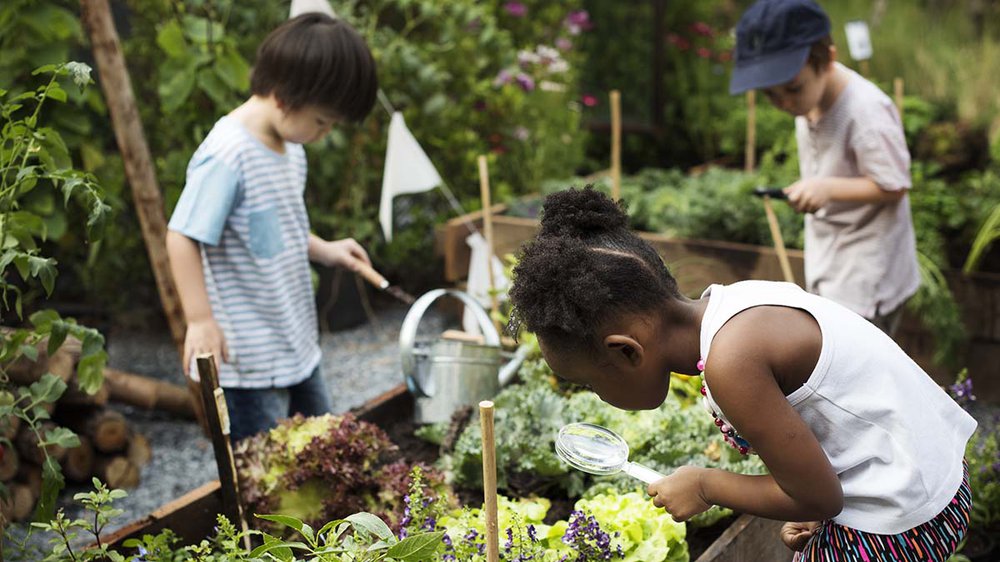Within the last ten years, more and more schools across the country are maintaining gardens as part of their curriculum. The gardens have flourished as a favorite activity in small and large to public and private schools. The Learning Counsel even conducted a Digital Curriculum Strategy Survey of 477 Schools and Districts that showed school gardens is a trend.
According to Laura Newcomer’s blog on Getting Schooled in the Garden: How to Start a School Garden, their growing popularity completely relates to the fact the students benefit more from gardening than learning how to plant, grow, and harvest their own food. Gardens teach students how to be more proficient in science and increase their knowledge in nutrition and consuming more produce. They also have the added benefit of improving social skills by encouraging compassion and teamwork, and engaging students who are otherwise difficult to teach.
Queen Creek Elementary School in Queen Creek, Arizona revived the school’s garden for their science program when its new principal Julie Oster arrived. “When I became principal last year, I saw what looked like garden beds under all these weeds and knew that we had some amazing potential.”
Deciding to bring the garden back to life, she teamed up with a teacher, who was an experienced gardener. Together with school parents, who donated everything, they started the renovation of the garden on Love Your School Day and worked over the Fall Break. When the students returned from break, they then could get to work on their new garden.
Oster asked teachers if they were interested in adopting a section of the garden for their class, where their students could work on various projects throughout the school year. Fourteen teachers volunteered consisting of several K-4 and two special education classes. While the special education classes worked on the garden every day, each K-4 class visited the garden at least once a week during their science block. They worked on the garden’s upkeep and were assigned various projects by the teacher. Assignments that were included consisted of identifying parts of the plant, pollination, life cycles and functions of the plant, decomposers, greenhouses, and hydroponics.
The students introduced an African Spurred Tortoise to the garden and created a habitat for the tortoise for various purposes. The habitat not only met the tortoise’s essential needs but gave the students the opportunity to observe the tortoise living in his natural surroundings. “Students in our Extended Learning Program are working to create a blog solely focused on our tortoise, Boulder, to educate others about the African Spurred Tortoise,” Oster explained.
Even though the garden is fairly new, the school has noticed not just academic benefits, but a very calming effect on the most difficult children. The school has more plans next year for a separate area within the garden designated as an outdoor classroom, where teachers conduct agricultural lessons.
Pinewood Elementary School, a TK-5 school, located in the northeastern Los Angeles community of Tujunga, joined the Pinewood Legacy Garden Project to transform their 1,500 square feet of the barren area of dirt alongside the school’s auditorium and school offices into a vibrant native garden.
The barren area of dirt is now a bountiful garden of native foliage. The garden draws birds and butterflies attracting students as they pass through the Pinewood campus. Two California native kinds of grass border a walkway that leads to a seating area cooled by fruit-bearing pomegranate, Fuji apple, and clementine trees. “Beautiful space not only helps students learn and bounce back from stress, it gives communities a sense of value,” noted Patrizia Puccio, principal at Pinewood Avenue Elementary School.
"We are very excited about this positive addition to our school and community. School gardens have been shown to improve school-wide academic achievement and student health, and they are wonderful places to educate the community about the environmental impact of our landscapes,” added Vickere Murphy, Retired Senator Carol Liu’s GREEN21 program manager.
These gardens will host recess, as well as, Beyond the Bell/ LA’s BEST After School Enrichment Program. Both this program and teachers will use garden curriculums designed by the Theodore Payne Foundation.
This idea of using gardens with our children and the role it plays in shaping our children is not a new concept. Back in 1918, Van Evrie Kilpatrick said in his book, In The Child’s Food Garden, With a Few Suggestions for Flower Culture, “The importance of encouraging our children in outdoor work with living plants is now recognized. It benefits the health, broadens the education, and gives a valuable training in industry and thrift. The great garden movement is sweeping over all America, and our present problem is to direct it and make it most profitable to the children in our schools and homes.”
If your school would like help to start a garden, here is Let’s Move School Garden Checklist










